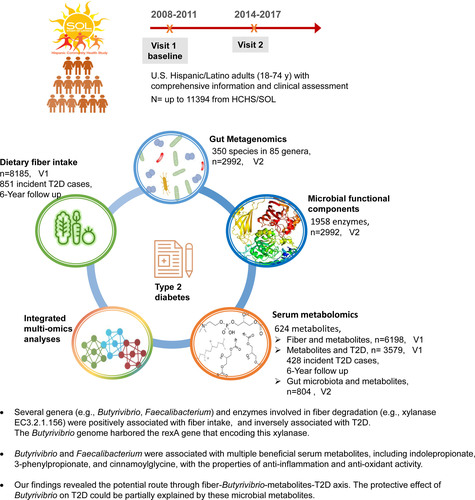Consistent evidence supports the protective effects of dietary fiber intake against type 2 diabetes (T2D), yet the underlying mechanisms remain inadequately understood, particularly concerning the interplay between gut microbiota, circulating metabolites, and T2D risk. Researchers in this study aimed to elucidate these relationships using data from the Hispanic Community Health Study/Study of Latinos (HCHS/SOL).
Key Scientific Findings:
- Association of Dietary Fiber Intake with Gut Microbiota: Analysis revealed associations between dietary fiber intake and specific gut bacteria genera, species, and enzymes involved in fiber degradation. Notably, genera like 𝘉𝘶𝘵𝘺𝘳𝘪𝘷𝘪𝘣𝘳𝘪𝘰 𝘢𝘯𝘥 𝘍𝘢𝘦𝘤𝘢𝘭𝘪𝘣𝘢𝘤𝘵𝘦𝘳𝘪𝘶𝘮 were positively associated with fiber intake and inversely associated with prevalent T2D, suggesting a protective role.
- Identification of Circulating Metabolites: The study identified numerous metabolites associated with fiber intake, with 47 linked to incident T2D. Among these metabolites, indolepropionate, 3-phenylpropionate, and cinnamoylglycine exhibited inverse associations with T2D risk, indicating potential protective effects.
- Relationship Between Gut Bacteria and Metabolites: Associations were observed between fiber-related gut bacteria and specific metabolites, suggesting a pathway through which gut microbiota may influence T2D risk. 𝘍𝘢𝘦𝘤𝘢𝘭𝘪𝘣𝘢𝘤𝘵𝘦𝘳𝘪𝘶𝘮 𝘢𝘯𝘥 𝘉𝘶𝘵𝘺𝘳𝘪𝘷𝘪𝘣𝘳𝘪𝘰 were associated with beneficial metabolites, attenuating the risk of T2D.
- Pathways Implicated in T2D Development: The study highlighted potential pathways linking dietary fiber intake, gut microbiota composition, circulating metabolites, and T2D risk. Specifically, the fiber-𝘍𝘢𝘦𝘤𝘢𝘭𝘪𝘣𝘢𝘤𝘵𝘦𝘳𝘪𝘶𝘮-metabolite-T2D axis and fiber-Butyrivibrio-metabolite-T2D axis were identified, shedding light on specific microbial mechanisms.
- Prospective Associations: Longitudinal metabolomics data revealed specific microbial-related serum metabolites associated with incident T2D over six years, supporting a prospective relationship between gut microbiota and T2D risk.
Methodology:
- Study Population: The analysis included 11,394 participants from the HCHS/SOL study.
- Dietary Assessment: Dietary fiber intake was assessed using two 24-hour dietary recalls at baseline.
- Microbiome Analysis: Gut microbiome composition was analyzed via shotgun metagenomics, identifying bacterial genera, species, and enzymes associated with fiber intake.
- Metabolomics Analysis: Serum metabolome was analyzed using untargeted metabolomics, identifying metabolites associated with fiber intake and T2D risk.
- Statistical Analysis: Associations between dietary fiber intake, gut microbiota, circulating metabolites, and T2D were examined using appropriate statistical methods, including adjustments for confounding variables.
This study underscores the importance of dietary fiber intake in modulating gut microbiota composition and circulating metabolite profiles, thereby influencing T2D risk. The identified pathways provide valuable insights into the complex interactions between diet, gut microbiota, and metabolic health.

Link to the article : https://tinyurl.com/bdecc6us